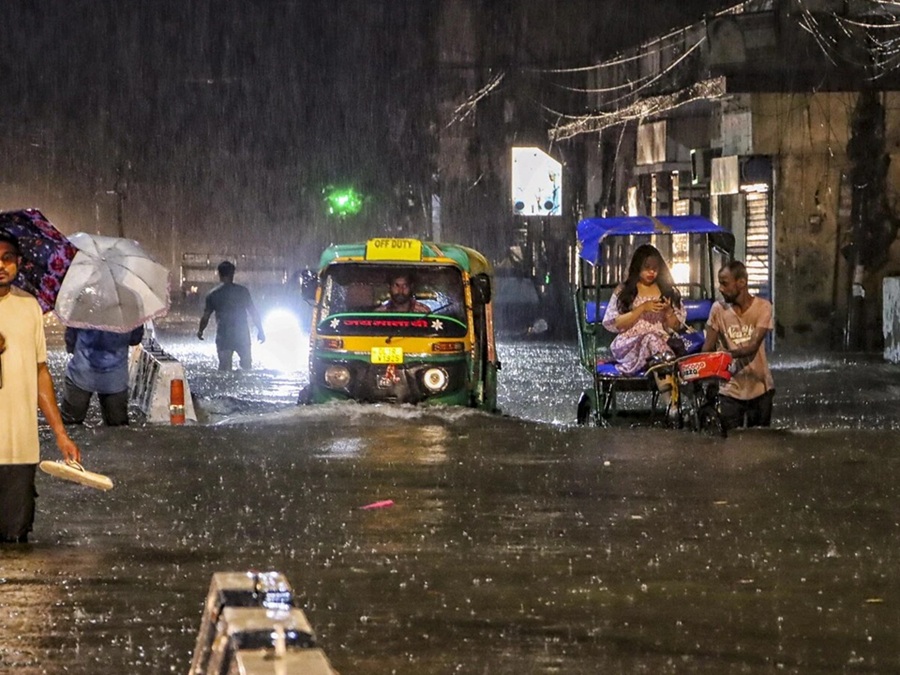Delhi was hit by a sudden and severe thunderstorm on the evening of May 21, 2025, bringing gusty winds of up to 79 km/h, torrential rain, and widespread disruption across the city. Low-lying underpasses, including the Pragati Maidan tunnel and sections of Mathura Road, were inundated within minutes, stranding vehicles and commuters in knee-deep water. Simultaneously, powerful gusts toppled several hoardings and uprooted trees in multiple localities, raising serious safety concerns over unsecured structures. Flight operations at Indira Gandhi International Airport were delayed or diverted due to reduced visibility and waterlogged runways, prompting airlines to issue passenger advisories. The India Meteorological Department (IMD) has forecast continued pre-monsoon thunderstorms, lightning, and gusty winds over Delhi–NCR for the next 48 hours, urging residents to remain vigilant.
What Happened?
On May 21, an intense cyclonic circulation over Haryana collided with an east–west trough stretching from Punjab to Bangladesh, drawing moisture from both the Arabian Sea and the Bay of Bengal. This meteorological setup generated a powerful storm cell that swept over Delhi by late afternoon, bringing sudden gusts of up to 79 km/h and heavy downpours. Streets rapidly flooded, and the rush-hour commute was thrown into chaos as traffic snarled in water-choked underpasses and major thoroughfares.
When Did It Occur?
The storm struck sharply around 4:00 pm local time on May 21, 2025, following a day in which Delhi recorded a maximum temperature of 40.7 °C and a heat index—affected by high humidity—of over 50 °C. Within ten minutes, many parts of the city witnessed waterlogging, with the Pragati Maidan tunnel submerged by 6 pm, forcing authorities to close it to traffic for several hours.
How It Unfolded
Subway Flooding
Delhi’s low-lying underpasses proved particularly vulnerable. The Pragati Maidan tunnel—constructed at significant cost ahead of last year’s G20 summit—was inundated so quickly that several cars and city buses stalled in the murky water. Similar scenes played out at the Minto Road and Purana Qila underpasses, where PWD crews had to deploy high-capacity pumps to disperse water and restore vehicular movement.
Hoarding Collapse
Simultaneously, powerful winds brought down multiple hoardings across the city. In South Delhi’s Saket district, a 20×10 ft unipole collapsed near a busy market street, narrowly missing parked vehicles and pedestrians. In Noida, Metro services were suspended temporarily after hoardings and tree branches littered tracks, endangering commuters.
Impact on Transportation and Infrastructure
- Road Traffic: Key arterial roads such as the Ring Road and Mathura Road experienced gridlock, with commuters reporting up to two-hour delays in knee-deep water.
- Air Travel: Over 40 flights to and from Delhi were delayed or diverted to alternate airports due to low visibility and a waterlogged runway at IGI Airport.
- Metro Disruptions: Several stations reported water ingress onto platforms and tracks. Greater Noida Metro services were suspended for two hours until lines could be cleared of debris.
- Power Outages: Numerous localities in East Delhi and Noida faced power cuts as the storm brought down trees onto transmission lines.
Government Advisory and Warnings
- IMD Warnings: The IMD has issued a red alert for Delhi–NCR through May 23, forecasting isolated heavy rainfall (up to 60 mm), frequent lightning, and gusty winds of 40–60 km/h. Residents are urged to avoid outdoor activities during peak storm periods and to stay away from hoardings and tree-lined streets.
- Airport Advisory: Indira Gandhi International Airport authorities have asked passengers to arrive at least three hours before scheduled departures and to stay updated via airline notifications.
- Delhi Metro Caution: The Delhi Metro Rail Corporation (DMRC) has cautioned commuters to expect possible delays at surface-level stations prone to waterlogging and to plan alternative routes where feasible.
- PWD/MCD Measures: The Public Works Department and Municipal Corporation of Delhi have mobilized stormwater pumps at 30 known flood-prone spots and instructed contractors to desilt drains immediately. Traffic police units have been deployed to redirect vehicles away from submerged roads.
Safety Recommendations for Residents
- Avoid Waterlogged Routes: Do not attempt to cross flooded underpasses or roads; even shallow water can stall engines and hide hazards such as open manholes.
- Keep Distance from Hoardings and Trees: Strong gusts can dislodge unsecured structures; maintain a safe distance from roadside hoardings, billboards, and large trees during thunderstorms.
- Stay Indoors During Lightning: Unplug electrical appliances, avoid using wired telephones, and do not stand near windows.
- Monitor Official Channels: Follow the IMD, DMRC, and Delhi Police on social media for real-time alerts and advisories.
- Keep Emergency Contacts Handy: Note helplines—Police (100), Fire Brigade (101), DMRC Control Room (155370).
Conclusion
The May 21 pre-monsoon thunderstorm laid bare Delhi’s infrastructural vulnerabilities—from chronically clogged drains to unsecured hoardings—while also highlighting the swift response of civic agencies and meteorological services. As the IMD forecasts continued stormy spells, residents are urged to exercise caution, heed official warnings, and stay updated through credible sources. Vigilance now will help minimize risk and ensure that Delhi weathers the remaining pre-monsoon activity safely.
